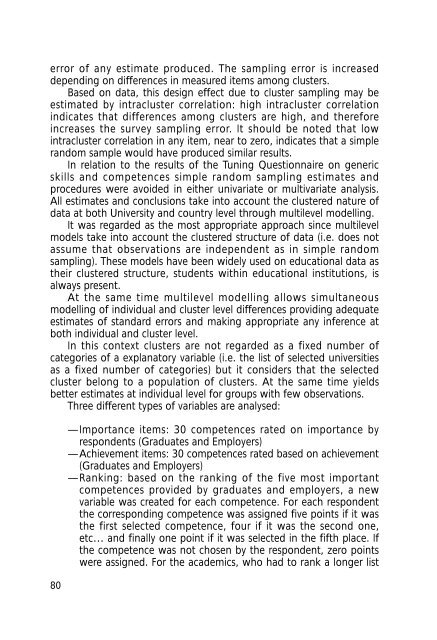Final Report Pilot Project - Relaciones Internacionales de la ...
Final Report Pilot Project - Relaciones Internacionales de la ...
Final Report Pilot Project - Relaciones Internacionales de la ...
You also want an ePaper? Increase the reach of your titles
YUMPU automatically turns print PDFs into web optimized ePapers that Google loves.
error of any estimate produced. The sampling error is increased<br />
<strong>de</strong>pending on differences in measured items among clusters.<br />
Based on data, this <strong>de</strong>sign effect due to cluster sampling may be<br />
estimated by intracluster corre<strong>la</strong>tion: high intracluster corre<strong>la</strong>tion<br />
indicates that differences among clusters are high, and therefore<br />
increases the survey sampling error. It should be noted that low<br />
intracluster corre<strong>la</strong>tion in any item, near to zero, indicates that a simple<br />
random sample would have produced simi<strong>la</strong>r results.<br />
In re<strong>la</strong>tion to the results of the Tuning Questionnaire on generic<br />
skills and competences simple random sampling estimates and<br />
procedures were avoi<strong>de</strong>d in either univariate or multivariate analysis.<br />
All estimates and conclusions take into account the clustered nature of<br />
data at both University and country level through multilevel mo<strong>de</strong>lling.<br />
It was regar<strong>de</strong>d as the most appropriate approach since multilevel<br />
mo<strong>de</strong>ls take into account the clustered structure of data (i.e. does not<br />
assume that observations are in<strong>de</strong>pen<strong>de</strong>nt as in simple random<br />
sampling). These mo<strong>de</strong>ls have been wi<strong>de</strong>ly used on educational data as<br />
their clustered structure, stu<strong>de</strong>nts within educational institutions, is<br />
always present.<br />
At the same time multilevel mo<strong>de</strong>lling allows simultaneous<br />
mo<strong>de</strong>lling of individual and cluster level differences providing a<strong>de</strong>quate<br />
estimates of standard errors and making appropriate any inference at<br />
both individual and cluster level.<br />
In this context clusters are not regar<strong>de</strong>d as a fixed number of<br />
categories of a exp<strong>la</strong>natory variable (i.e. the list of selected universities<br />
as a fixed number of categories) but it consi<strong>de</strong>rs that the selected<br />
cluster belong to a popu<strong>la</strong>tion of clusters. At the same time yields<br />
better estimates at individual level for groups with few observations.<br />
Three different types of variables are analysed:<br />
80<br />
—Importance items: 30 competences rated on importance by<br />
respon<strong>de</strong>nts (Graduates and Employers)<br />
—Achievement items: 30 competences rated based on achievement<br />
(Graduates and Employers)<br />
—Ranking: based on the ranking of the five most important<br />
competences provi<strong>de</strong>d by graduates and employers, a new<br />
variable was created for each competence. For each respon<strong>de</strong>nt<br />
the corresponding competence was assigned five points if it was<br />
the first selected competence, four if it was the second one,<br />
etc… and finally one point if it was selected in the fifth p<strong>la</strong>ce. If<br />
the competence was not chosen by the respon<strong>de</strong>nt, zero points<br />
were assigned. For the aca<strong>de</strong>mics, who had to rank a longer list


